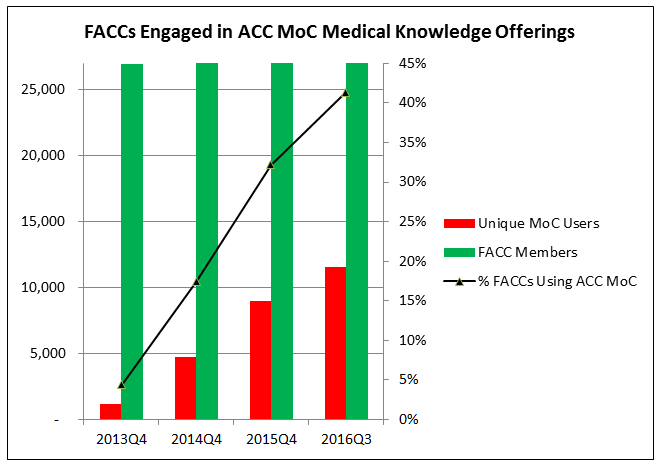November 18, 2016
What works best in your Chapter for member/patient benefit?
This week's BOG Update is brought to you by Executive Vice President, Science, Education, Quality, and Publications at the American College of Cardiology, William Oetgen, MD, MBA, FACC.
MOC Update: MOC Module Use Among ACC Members
One of the charges of the ACC Board of Trustees regarding the American Board of Internal Medicine (ABIM) Maintenance of Certification (MOC) is that the College should develop multiple educational modules for ACC members who elect to participate in MOC. The College's Education Division has taken on this responsibility, and – working with members – has created many new opportunities for earning dual Continuing Medical Education (CME) and MOC credits over the past two and a half years.
A recent example of these new opportunities include collaboration between ACC's Education staff and the Publications/Journal of the American College of Cardiology (JACC) Journals staff to offer dual CME-MOC credit for selected JACC journal articles. This program began in August 2016, and currently 13 articles are available for dual credit.
The articles span all JACC journals, and up to 60 dual CME-MOC credits will be offered to members over the course of a year. It is now possible for ACC members to fulfill the virtually all of their CME and MOC requirements simply by going online and participating in these educational offerings periodically.
The response to this program has been robust. There have been 938 MOC credits claimed by 519 unique ACC members. It is difficult to fully benchmark the response, but this represents a 22 percent increase in MOC participation by unique ACC users over the comparable time period in 2015.
Overall, MOC participation by College members continues to rise.

The graph illustrates that since the end of 2013, there has been a steady rise in the number of unique users of College-based MOC medical knowledge offerings. At the end of the third quarter of 2016, 43 percent of FACCs have accessed MOC learning modules on ACC.org. The increase in users has been steady, and the number of unique participants is expected to rise to 50 percent by the end of 2016.
From the perspective of ABIM diplomates in cardiovascular disease and in cardiovascular subspecialties, the current participation in MOC is shown in the chart below.

MOC participation by all cardiovascular diplomates is at 62 percent. This includes "grandparent" diplomates who are not required to participate in MOC because they have lifetime certificates, issued before 1990. MOC participation among grandparent diplomates is 35 percent, while subspecialty participation is higher with 73 percent of electrophysiologist diplomates participating, 74 percent of interventionist diplomates, and 69 percent of heart failure diplomates participating.
The focus of the College's discussions with ABIM is now centered around developing a model option to offer an alternative to the current 10-year, high-stakes examination. If the College's efforts are successful, participation in the ACCSAP program may become an alternative to the Part III requirement as it is currently configured.
Finally, several other opportunities to gain CME/MOC credit are now offered through the ACC. ACCSAP 9 offers up to 155 dual CME/MOC credits. Also, after a very successful dual credit pilot during a small selection of sessions at the ACC.16 Annual Scientific Session, dual CME/MOC credit will be available at virtually all sessions at ACC.17 will offer dual credit. Many of ACC’s live courses will also offer dual credit beginning in 2017, such as the Cardiovascular Conference at Snowmass and the NY Cardiovascular Symposium.
